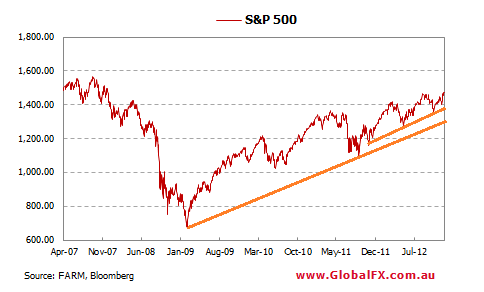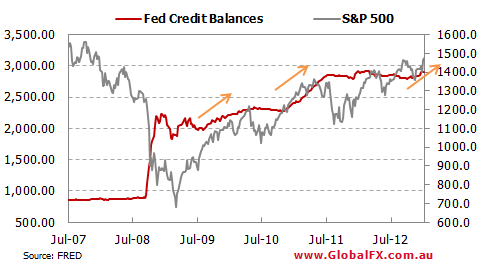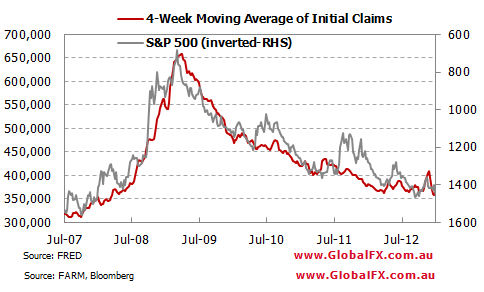
The title of this post is one of the most important statements in all of Jesse Livermore’s great book “Reminisences of a Stock Operator” but it is also one of the hardest market axioms to adhere to because often rhetoric gets in the way. Often economic reality gets in the way or often our personal biases get in the way.
So the news that stocks have touched their highest level since 2007 with all the bad news and unemployment in the globe is clearly going to be incongrous to many people.

But as you can see in the chart above the S&P 500 has had periods of weakness over the past few years but if you take a step back and look at the big picture it now approaching the 4th year of a bull market – even if it is within the overall “sideways” market that has been occurring since 2000. This is what The Prince often terms as the difference between a “cyclical” bull market and “structural” bull market.

This is of course the aim of zero interest rates and unconventional monetary policy, expanding central bank balance sheets goose stocks for long enough get money allocated away from savings and put to work and get rates low enough so business can take a few risks and hire people.

You can see in the chart above of Fed Credit Balances against the S&P 500 and the performance of the market when the Fed’s balances were expanding and when they were static or contracting. Expanding equals stocks up. Static or falling equals stocks down. So the Fed’s current purchases of bonds and its helicopter drop in the economy is likely to do the job.
And perhaps the Jobless Claims data we saw overnight, which showed a fall to 335,000, could be suggestive of an improving employment outlook in the long run. As you can see in the chart below this data seems to be vitally important for the health of the stock market.

I never thought to plot jobless claims against the market but I have seen Joe Weisenthal from Business Insider wax lyrical about this chart many times and as you can see it seems to have a pretty good track record. Which of course makes sense, an improving employment market feeds into economic activity very strongly and with a high multiplier for each additional job created.
So put simply for the moment there is little selling pressure in US equity markets.

And as you can see in the weekly S&P 500 chart above the market is not stretched by any sense in terms of my usual technical indicators.
Clearly I need to remember what Jesse Livermore said “its a bull market son”. Yet I remain skeptical.
Because at some point the positives of the improving employment situation are going to collide with the positive of the Fed’s unconventional policy of buying bond after bond after bond is withdrawn. We know that point – it is 6.5% US unemployment and we know the Fed will cease its money drop.
So we know where the risk to stocks will come. It’s just the timing we don’t know and the big question is whether the market will have enough self sustaining momentum to continue higher on its own without the Fed. It is then that we will know if this is a cycilcal or structural bull market.
But that time is not yet come.